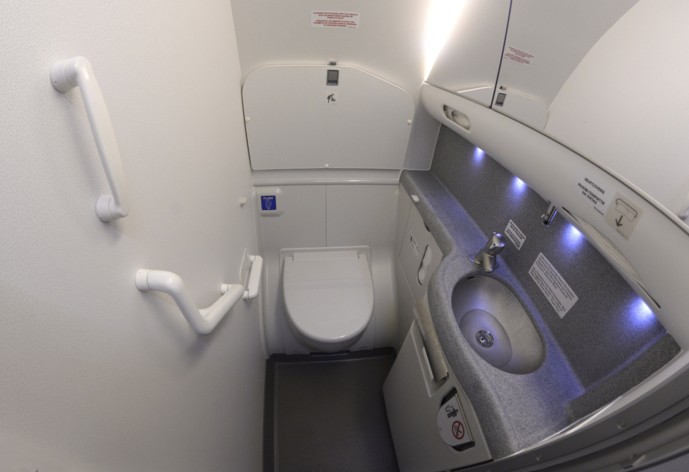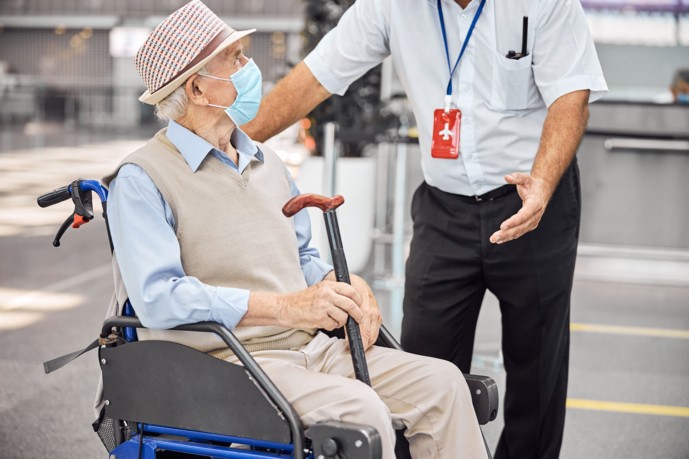Accessible travel: Thinking beyond horizons!
14.12.2021
Flying is often associated with freedom - one of our most important fundamental rights. Accessible travel is an important keyword here: numerous regulations are designed to ensure that persons with reduced mobility (PRM) are not disadvantaged in any way. Aircraft are supposed to offer barrier-free access to lavatories, seats and much more - but not all fleets offer a barrier-free flight experience. Reasons for this are partly due to the different regulations of individual countries or state associations. The following BLOG provides an overview of the most important legal regulations.
European regulations and agreements for air travel by people with reduced mobility
The main European legislation governing the rights of people with reduced mobility when travelling by air is Regulation (EC) No 1107/2006. The Regulation applies to all European air carriers and their flights departing from or arriving at a European airport. It also applies to European air carriers departing from or arriving at an airport outside the European Union (EU). In doing so, the regulation defines the rights of disabled persons and persons with reduced mobility when travelling by air.

Accessible travel
Accessible travel means that all essential information and means of travel for disabled persons or persons with reduced mobility are made available in alternative formats.
- The main points of this European Parliament Regulation are as follows:
- Persons with reduced mobility have the same right to freedom of movement, choice and non-discrimination as all other citizens. This applies to air travel as well as to other areas of normal life.
- Persons with reduced mobility must be accepted for carriage and not refused boarding on the grounds of their disability or lack of mobility, as long as safety on the aircraft is not compromised.
- In the event of disruption of air travel, the same reimbursement rights and rebooking rules apply.
- The same rule applies to airports as to air transport. Airports must meet their needs for services for disabled persons and persons with reduced mobility. To do so, staff must be trained and the right equipment must be available at no extra cost. (EC 1107/2006, 2006a).
Important legal milestones
The most important milestones in PRM perspective laws and agreements date back to 1986. The Air Carrier Access Act (ACAA) was published in the United States to prohibit any discrimination against disabled passengers by air carriers. The Act has significantly improved the way disabled passengers are treated.
Canadian Accessibility in National Transportation Act & Accessible Canada Act
In 1987, the Accessibility in National Transportation Act was published in Canada, with the Accessible Canada Act currently in force in Canada. This regulation requires organisations to develop standards, make recommendations, promote, support and research the removal of barriers and prevent new barriers. The provision of information and best practices is mandated by this Act (Accessible Canada Act 2019).

Americans with Disabilities Act (ADA) and Air Carrier Access Act (ACAA)
In 1990, two other laws were passed in the USA:
- The Americans with Disabilities Act, which prohibits discrimination in all areas of public life (Americans with Disabilities Act 1990) and
- The final ACAA regulation (US Department of Transportation, 1990, 14 CFR Part 382).
Australian Disability Discrimination Act (DDA)
In 1992, the Australian Disability Discrimination Act (DDA) was passed. Under this Act, it is unlawful to discriminate against a person because of a disability or the disability of a person's dependants, such as friends, partners, support persons or even family members (Disability Discrimination Act 1992).
Regulation (EC) No 1107/2006 on the rights of disabled passengers travelling by air and the European Accessibility Act 2019
The year 2006 was an important year in the European Union as Regulation (EC) No 1107/2006 was published. Eight years later, in 2014, the European Aviation Safety Agency (EASA) published the Regulation on the carriage of special categories of passengers (EASA 2014). The year 2019 was outstanding as there were three major milestones:
- The European Accessibility Act was adopted after four years.
- The Accessible Transportation for Persons with Disabilities Regulations Canada were revised along with the
- EC1107/2006 also revised.
US regulations
The DOT regulation 14 CFR Part 382 concerns European air traffic. It defines some specific standards for operators flying from Europe to the United States of America or vice versa (US Department of Transportation 2020b). Rule 382.67(g) states that foreign air carriers flying to the United States must provide adequate space in the cabin for the storage of passengers' wheelchairs. This rule applies to all aircraft with 100 or more seats.
"As a foreign air carrier, you must comply with the requirements of this section for new aircraft ordered after May 13, 2009, or delivered after May 13, 2010." (US Department of Transportation, 2020c)

As a foreign air carrier, you must comply with the requirements of this section for new aircraft ordered after May 13, 2009, or delivered after May 13, 2010.
US Department of Transportation, 2020c
Wheelchair accessible lavatory
Wheelchair accessible lavatories are available on many of today's wide-body aircraft, but not every aircraft is equipped with them. US law requires airlines to provide an on-board wheelchair (OBW) without an accessible lavatory on aircraft with more than 60 passenger seats (US Department of Transportation, 2020d). European legislation does not currently require OBWs or accessible lavatories on narrow-body aircraft.
Single-aisle aircraft
Some airlines have installed accessible lavatories on narrow-body aircraft, but are not legally obliged to do so. Travellers cannot therefore rely on there being an accessible toilet on a narrow-body aircraft.
In Europe, air carriers are obliged to inform persons with reduced mobility about possible restrictions related to inaccessible toilets, lack of movable armrests and seating restrictions (Commission Staff Working Document, Articles 4 and 5). Operators are encouraged to indicate possible cabin restrictions on their website. It is therefore advisable for persons with reduced mobility to inquire at the time of booking which type of aircraft is envisaged for the route in question.
Differences between the US and EU regulations
Key differences between the US and EU regulations are that the DOT regulation states that airlines are solely responsible for providing accessibility services to PRMs. In EU regulations, responsibilities are divided between airports and airlines. Accordingly, airlines in the EU are only responsible for on-board assistance.
Future proposals for improvement
The US Department of Transportation is currently taking a close look at this issue and has initiated a process to solicit comments. The proposed document, called "Accessible Lavatories on Single-Aisle Aircraft; Part 1" defines the need to change US regulations. This specific Notice of Proposed Rulemaking (NPRM) is intended to propose specific measures to improve lavatory accessibility on single-aisle aircraft with 125 or more passenger seats. Special consideration will be given to the needs of passengers with reduced mobility and disabled passengers.

The extensive proposals for improvement include:
- Changes to the structure and interior of the lavatory.
- Additional services related to access to the lavatory.
- New training requirements and improvements to OBW carriage.
Regarding the on-board wheelchair, three main suggestions are included:
- The OBW should be able to operate in the aisle of a narrow-body aircraft.
- The OBW should have a suitable certified stowage space on board in which it can easily fit.
- The OBW should work without any modifications to the interior of the current aircraft lavatories. This seems to be a little complicated, as OBWs in current toilets usually do not.
What about European regulations?
For the European Union, Regulation (EC) No 1107/2006 of the European Parliament and of the Council of 5 July 2006 lays down rules on the protection of and assistance to disabled persons and persons with reduced mobility when travelling by air. In accordance with Regulation (EC) No 1107/2006, airports and air carriers should take into account Document 30 when organising assistance to disabled persons and persons with reduced mobility, and when training their staff. Document 30 of the European Civil Aviation Conference (ECAC) is a guide for the organisation of assistance.

For European countries outside the EU, national regulations must be taken into account. Regulation EC 1107/2006 needs to be revised. All services should be provided regardless of aircraft type. The EU limit could be more or less the same as the planned US regulation, i.e. all aircraft with at least 125 seats must have an OBW and an accessible toilet.
The European legislation EC 1007/2006 is currently being revised and updated - the results are not expected until 2022 at the earliest.
Conclusion
Regulations and guidelines on accessibility provide a good basis for their implementation, but they cannot guarantee them or their practical application. In Europe, EU Regulation (EC) 1107/2006, Annex II, would be the right instrument to include the requirement for accessible lavatories on all aircraft. Annex II simply states that the operator must make all reasonable efforts to meet the needs of persons with reduced mobility, including assistance in using the toilets (EC 1107/2006 Annex II 2006b). Regulation EC 1107/2006 needs to be revised. All services should be provided regardless of the type of aircraft. The EU limit could be more or less the same as the planned US regulation, i.e. all aircraft with at least 125 seats must have an OBW and an accessible lavatories. This would also protect airlines from potential complaints from persons with reduced mobility or disabilities.
Accessible lavatories on narrow-body aircraft are a badge of a modern airline. Inclusive design and inclusive marketing are not only a contemporary way of thinking, they are indispensable in reality - for the population, for a strong togetherness, for the way forward. These issues are an important sign and a big, significant step towards #EqualEverywhere. A step we will always take here, at FACC.











